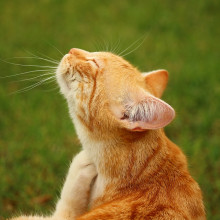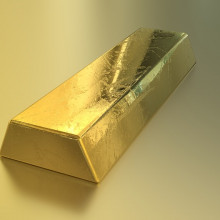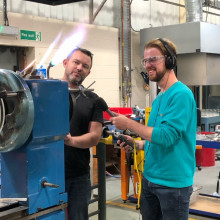Crystal Clear About Glass
This week, we’re taking a look through the window, or rather, at the window: we’re looking at glass! Coming up, how do you make glass, how does stained glass work, and is bullet-proof glass really bulletproof? And in the news: Why birds are in big trouble, swimming the channel, scratching an itch, and a potential cure for the common cold...
In this episode

Birds disappearing from America
Ken Rosenberg, Cornell University
Around the world, millions of people have united to campaign for action on climate change. There’s significant concern about what’s happening to the environment and the world’s flora and fauna. And we need to worry, because many species are coming under significant pressure. The birdsong we hear walking through a forest may be replaced with silence. Chris Smith spoke with Ken Rosenberg, wo is at Cornell University in the US where he’s been studying bird populations and habitats, and his latest findings, which have been published in the journal Science, should certainly put the cat among the proverbial pigeons…
Ken - This study is showing a staggering loss in the abundance of birds all around us in North America. We're seeing about a 30 percent loss in the total number of birds out there since 1970. That's a loss of 3 billion birds, which means that our best estimates is that there were about 10 billion breeding birds in 1970, and about 7 billion birds today.
Chris - And if you stratify by all the different species, who are the biggest losers or is everyone the loser here?
Ken - Well we saw large losses in almost every habitat group. The biggest losers are probably grassland and farmland birds, because they showed the largest proportional loss. More than half of their population gone since 1970, and also the largest absolute loss, about 700 million birds from their population was lost. But there were smaller levels of loss in almost every habitat.
Chris - Were there any winners? Did the numbers of any rise to compensate?
Ken - There were. So in North America where most of the conservation investment has been, is in waterfowl and wetland birds. And that showed up in the data. The wetland bird group was the only group to show an increase. Waterfowl populations have more than doubled in that same time period since 1970, and that's because of the investment in wetland restoration, waterfowl management, primarily for recreational hunting.
Chris - I'm intrigued to know how you actually have managed to count three billion birds.
Ken - We used a lot of different survey data sources, because there are so many bird watchers out there we have a lot of eyes and ears, and by organising standardised surveys that use volunteer birders to count birds, 400 species are covered pretty well by this Breeding Bird Survey, and then we brought in other surveys such as the Christmas Bird Count to look at birds that we only see in the winter. So basically we put together the best information we had for each bird group.
Chris - But in the paper you also talk about using radar?
Ken - Right, weather radar gives you a picture of the total mass of birds that are migrating over the continent in any given time, and these birds are flying at night. And so the radar is picking up the total biomass of their migration at night, and by looking at that number over time, so over an 11 year period we saw a reduction in the total biomass of migrating birds. That was about the same magnitude of decline as we were seeing in the survey data. So two completely independent methodologies and data sources were showing the same results.
Chris - What do you think the mechanism underpinning all of this is? Do you think there's one single mechanism or do you think there's a range of factors here?
Ken - There's definitely a range of factors. We have a pretty strong sense that habitat loss and degradation is the primary driver for most groups of birds, but there are many things that kill birds that are human caused, and they range from pesticides, cats, windows, collisions with buildings and towers. There is lots of different drivers, pinning them down to the specific decline of any species is very difficult to do and that's really the next phase of our research.
Chris - I'm very alarmed by the scale of these figures, and not just the scale but how quickly this has kicked in, and the reason for asking the question about what you think the mechanism is, is that well, if we're going to try to arrest that decline, we need to know what's causing it. And it doesn't sound like you've got a clear picture on that yet. So it's going to be really really hard to get a handle on this, and perhaps it's too late already. Would you say?
Ken - Well, I don't think it's too late for most groups, and we do know that bird populations are very resilient, and we have this model from wetland and waterfowl to to guide us. We know that with bald eagles and other raptors, when we saw a problem with DDT and we were able to ban those pesticides, and stop those birds from being shot, their populations did rebound, and so we need to replicate those successes. So in grasslands we need some changes in agricultural policy that allows there to be some native grassland on the habitat, and agriculture has become so intensive that it has just squeezed birds off the landscape, where even 10-20 years ago there were more birds that we were able to live side by side with. So it's going to take a lot of different actions at the individual level, at the societal level. But we are hopeful, but because we know that this has worked in other cases.
Chris - You've got this in North America, but do you think this is, it’s a horrible analogy but the canary in the coal mine for what's going on in geographies worldwide? If I did the same sort of study in Europe, or in Russia, or in Australia, would I see a similar trend?
Ken - Absolutely and these papers are coming out one after another about declines in birds in Europe, declines of insects globally, this is a global phenomenon. The loss of biodiversity, the loss of species, the loss of abundance, so the canary in the coal mine analogy is exactly correct today. This is telling us that there is something dreadfully wrong in our environment, we can see what's going on with birds because they're so conspicuous and we can count them. So we can be sure that what it's telling us, is that these things are going on with other groups as well and that we're seeing an unraveling of ecosystems and a degradation of the health of our overall environment. It has to be happening if the losses are so pervasive as we're seeing.

07:35 - Swimming the channel
Swimming the channel
Christof Schwiening
Sarah Thomas set a new world record this week when she became the first person to swim the English Channel four times over, non-stop. She was in water at 18 degrees Celsius and swimming constantly for fifty-four hours. Phil Sansom spoke to Christof Schwiening from the University of Cambridge, about how she accomplished it...
Phil - Just after dawn on Tuesday morning, Sarah Thomas staggered onto Shakespeare Beach in Dover and became the first person ever to swim the Channel four times non-stop.
Sarah is an American long-distance swimmer, 37 years old, and a survivour of breast cancer. Now, the year after she’s finished her treatment, she’s set a world record.
How did she do it? How did she bounce back from cancer therapy to spend more than two days in nail-bitingly cold water, swimming what was supposed to be the length of three marathons, but thanks to strong tides ended up being closer to five?
Well, it’s partly thanks to physiology.
Sarah’s trained for a number of challenges, the first of which is energy. She kept her calories up by drinking from a protein recovery drink every half an hour. But to use those calories most efficiently, she needs a certain type of muscle, called type 1 or slow twitch muscle. It’s red muscle, the kind that gives you dark meat from a turkey. Unlike type two fast-twitch muscle, slow-twitch muscle is really good for endurance, because it’s really good at using oxygen. It has a high blood supply, it has little molecules called myoglobin that take the oxygen out of the blood, and it has lots of mitochondria for turning that oxygen into energy. Perfect for long-distance exercise. And with training you can turn more of your muscle fibres into type one.
Phil - The second challenge is the cold. Christof Schwiening is a physiologist from Cambridge University who was pretty impressed with this feat.
Christof - If I were to fall into the English Channel, I wouldn’t survive for more than about 1 hour or so. So, how is it that Sarah managed to survive for 54 hours in water close to 18 degrees C? Well, what Sarah has managed to do is minimize the extent and consequences of the hypothermia she will have suffered during the swim.
Phil - She didn’t even wear a wetsuit - only a cap, goggles and a swimsuit! She had to have trained her body to avoid losing heat wherever possible.
Christof - The major adaptation that minimizes heat loss is simply keeping warm blood away from the cold water – that occurs through the restriction of blood flow to the skin and the presence of a relatively thick layer of subcutaneous fat.
Both of these are not unique to Sarah, but what Sarah seems unusually good at is maintaining a continuous high heat output even when her core body temperature has fallen to a level where most of us would be a shivering wreck. Part of that ability is her aerobic fitness – with an ability to continuously metabolize fuel.
But, she must also have managed to ‘train-out' her shivering response – shivering is counter-productive when swimming - and this is a well-known adaptation in people who are routinely exposed to the cold.
Phil - All this meant that she coped surprisingly well with the cold! She said the worst part may have been the salt water, drying out her mouth and throat. She even got stung by a jellyfish. And through all of it, she kept going.
Christof - So, I suspect that Sarah – physiologically – is not that unusual. Sarah’s real strength comes from her ability to focus her mental effort on continuing to put one arm in front of another when even the most simple mental task becomes almost impossible. That requires practice and stamina that few are able to muster.

Curing the common cold
Ian Goodfellow, University of Cambridge
Most of us succumb to an average of 3 coughs and colds per year. The main culprit in over half of cases are viruses called rhinoviruses and enteroviruses. When a symptomatic person sneezes, they spray out a mist of millions of these particles that drift about in the air waiting for you to breathe them in. Once they settle on the cells in your nose and throat, they invade, hijack the cells and transform them into virus factories; and then cycle starts all over again, making you feel awful in the process. But in a new study in the journal Nature Microbiology, Jan Carette and his team at Stanford University have identified a protein in our cells that these viruses rely on when they grow. And cutting off the supply of this substance halts the viruses in their tracks. So could this potentially pave the way for a cure for the common cold? Cambridge University virologist Ian Goodfellow took me through the results of the new study…
Ian - In this paper they've essentially identified a host protein that appears to be essential for a number of viruses that cause the common cold and enteric infections. When they’ve deleted this gene encoding this particular protein, the viruses are no longer able to infect cells.
Chris - How did they find the gene in question?
Ian - To identify the gene, they used a process to delete every single gene in human DNA.
Chris - Is that what, one by one? So they go through the entire genome, and one at a time disable one gene after another, and then test whether or not that disabled gene has an effect on the virus?
Ian - Exactly that. So you mutate every single gene one by one, then you infect them with the virus, and then you look for cells that survived. And these cells that survived are resistant to infection, and therefore have a mutation in a gene that is essential for the virus life cycle.
Chris - Right. So they identified a gene. What is that gene that they've found that seems to be so important, and do they know why disabling it has this effect on the virus?
Ian - The gene itself was called SETD3, it's a protein known as a methyltransferase. And they don't know exactly what stage in the virus life cycle it plays its role, but they know that in the absence of this protein the cells are largely completely resistant to infection.
Chris - They show that in the dish to start with, but would that work in a living animal? Because it's one thing to disable a gene and have a cell still thrive in a dish, but very different with a whole animal in which you are trying to do this.
Ian - This is one of the beauties of this particular publication. They've translated their observations from immortalised cells into a whole organism model. So they've taken a mouse model and they've inactivated this gene, and shown that when you infect these mice with these various viruses, they're completely resistant to infection.
Chris - And clinically, what's the relevance or use of this discovery? How could virologists now take this forward, and is it potentially a doorway towards - I hate the phrase - but a cure for the common cold, or at least some forms of the common cold?
Ian - So what this paper does is it really identifies a key whole-cell protein that's important for a whole group of viruses that cause a range of diseases. It isn't immediately like tomorrow we can all of a sudden develop a drug to this particular protein, but what it does is it says, if we find a way to modify the function of this protein then we probably have an effective way of treating, or controlling, or preventing the infection by these viruses. So it identifies SETD3 as an essential component in the virus life cycle. And if you can make drugs that target SETD3 you might be able to inhibit the virus replication.
Chris - Could the same strategy be used for other clinically relevant infections? Because colds are one thing, they're a nuisance, but they're not by any means the main way in which viruses bring down the human race.
Ian - Yes, exactly, and it's become increasingly common in virology now for individuals to use this precise approach, where you use CRISPR-Cas screening to identify host proteins that are essential in a virus life cycle, and then to use that as a potential target for therapeutic approaches. And just recently we've undertaken some work on a related family of viruses known as noroviruses - that cause gastroenteritis - to do precisely the same type of approach. And when we've done that we've done a CRISPR-Cas screen to identify a single protein known as G3BP1. This protein is absolutely essential for both the mouse norovirus replication and for human norovirus replication. And we hope that in the future this will enable us to develop a potential therapeutic approach for the control of norovirus-induced gastroenteritis.
Chris - Viruses are notorious for being able to change their genetic makeup; they mutate or change. If we did work out how to use these vulnerabilities, to make drugs to block them, is there not a high likelihood that pretty quickly, the viruses would fight back by just adjusting their modus operandi to bypass whatever block we put in the way?
Ian - This point about the development of resistance to drugs is a real key factor when we consider developing any sort of therapy for viruses. And as you say, viruses change very rapidly. But when we target a host protein it's very, very difficult for the virus to change to overcome that. It's not impossible, but it's much easier for a virus to develop resistance to drugs that target viral proteins than it is for it to develop resistance against drugs that target the host.

Itching IgNobels
Francis McGlone, Liverpool John Moores University
This week, a very special scientific award show was held at Harvard: the 29th Annual Ig Nobel Prizes. But what science deserves such an accolade? Adam Murphy spoke with Francis McGlone, from Liverpool John Moores University, about the power of his research on scrating an itch…
Adam - On the 12th of September, the most prestigious award show was held: the Ig Nobel Prizes. Only the best of science gets awarded these prizes. This year they went to groundbreaking work such as showing that a pizza may protect against illness and death if that pizza is made and eaten in Italy, for a better understanding of cubic wombat poo, and for an estimation of the amount of saliva produced by a 5 year old. OK, so maybe not what you'd think about at first glance, but the Ig Nobels go to science that makes you laugh and then makes you think, science that may sound quirky but has importance behind it. One of this year's winners was Francis McGlone from Liverpool John Moores University, who, along with Gil Yosipovitch and others, examined the pleasurability of scratching an itch - you know that feeling when you've got an itch, and you just have to get to it, and then the relief of finally getting rid of it. Francis spoke with me about the work he's done.
Francis - In this experiment we looked at different body parts to see where itching was most accompanied by pleasure, basically. So we looked at these three different body sites and asked people after we'd made them itch, which one was the most rewarding, and I think it’s the quirkiness of that experiment that attracted an Ig Nobel. But underneath this almost sort of obvious question about why do you want to scratch an itch, there's an underlying question of why when you scratch that skin is it so rewarding. And this is what really interested me because the skin that you've just scratched, if you scratched the skin when it's not itchy, well it's actually quite uncomfortable. But once we create an itch, scratching that skin site again becomes absolutely deliriously rewarding.
Adam - As I've mentioned, Ig Nobels have to make you think. They can't just be quirky. So what does this work make you think about?
Francis - This research has clinical implications as well because chronic itch is a condition where patients just cannot ignore scratching a piece of skin, until it's quite often damaged. So that itch-scratch cycle is a clinical feature in many chronic conditions. Most people appreciate chronic pain conditions, and can have some sympathy with people suffering from pain, but itch doesn't really get the kind of credibility it needs I think, in terms of how debilitating it is for people. A good example I have was a patient who had his foot blown off on a landmine and this often results in a phantom pain from that missing limb. But this patient claimed it was a phantom itch between the big toe and the toe next to it. So he had an itch coming from a foot that wasn't there, and I think most people can appreciate just how devastating that can be to not be able to get at an itch. So again, we need to look at underlying mechanisms as to why itch is so pervasive, why it cannot be ignored, and in clinical conditions how best we can treat chronic itch. And of course with all of these interesting questions, first of all we need to understand the mechanisms and then we're in a better position to try and treat such conditions.
Adam - There's a good chance just after hearing that you're now a bit itchy. When all is said and done and all issues have been scratched and the prizes given out, where does Francis think the Ig Nobels fit into the world of science?
Francis - I think the Ig Nobel Prizes have been running for quite some time now and they really do add a very important element to us as scientists in terms of getting outreach or enabling us to tell our stories to wider audiences. All the Ig Nobels are based on good science, but a bit wacky. I think that opens a door to drawing audiences in that may not necessarily be interested in our areas of science, but they're drawn in by the quirkiness, and then of course, underneath that, they get exposed to the basic science questions that are being answered and asked within these research areas. And I think the Ig Nobel provides an absolutely superb mechanism by which the general public or the wider public can become aware of the kinds of things we do as scientists.

23:30 - Mailbox: Gold bars and gravity
Mailbox: Gold bars and gravity
This week, Peter Bridger has been in touch about an interesting experiment involving gravity and a gold bar, and Rob Clements is closing to completing a truly iconic challenge...
Chris - We’re onto the mailbox now, this is the part of the program where we read out your correspondence. Now Peter Bridger has got in touch from Australia, and he sent us a very nice letter. It went actually all over the place, before it finally arrived to us. I'm sorry we're coming to this slightly late Peter, but he's been in touch telling us about the time that he spent here in Cambridge, because he was originally working with centrifuges, and this got him thinking and wondering about gravity, and so he's proposed an experiment and he says: Well could you take a gold bar all over the world and measure the gravity that it feels at the equator compared with the poles. And the rationale behind this idea is that because the equator is spinning a lot faster than the poles are, then the bar ought to weigh a bit less there apparently, because it's not being flung out into space at the poles in the same way as is at the equator. Adam is that a good idea?
Adam - I think it is. I mean the first thing to say is; we're not going to get flung off the planet like some horrifying roundabout, gravity is much much stronger than any spinning the Earth does. But it's a very good experiment because it's one that's been done a lot throughout history, and they've found but in different parts of the world gravity actually is different, and they found that it can waver by up to about 0.5% of how heavy something is. So in cities like Kuala Lumpur or Singapore which are by the equator, something is half a percent lighter than it is in places like Oslo because that's at the poles.
Chris - Pretty extreme way to go on a diet though isn't it? To go down to the equator just to lose a little bit of weight.
Adam - I mean if that's what you gotta do to make yourself feel better about scales that's what you got to do.
Chris - So it has been done?
Adam - It has. Yes. Not only have they gone to these places with weighing scales because that's how you measure how much something weighs we've had satellites in orbit measuring these things.
Chris - That's GRACE isn't it? The pair, or brace of satellites that actually whiz round the Earth and measure how fast one's accelerating relative to the other, because that's how they weighed the ice on Greenland to know what the rate of ice retreat was.
Adam - It's the Gravity Recovery And Climate Experiment is GRACE. And when one of them passes over somewhere heavy it gets pulled a bit ahead and then the other one catches up and that's how it measures things.
Chris - Thank you very much Adam. Meanwhile quick shout out to Rob Clements. Now he's in Nottinghamshire, and he's one of a very select band of brothers if I can put it like that because he's completed the audio equivalent of an ironman challenge, because he’s made it through our entire Naked Scientists podcast catalogue close to 1000 episodes going back to the very beginning. We’re one of the oldest and longest continuous running podcasts in existence so that's quite a feat. He has now reached August 2019, so Rob that red tape is in sight you're almost up to date, you're almost back in sync with the program. We're very intrigued to know if anyone else has managed a marathon like this, so if you're one of that band of brothers do let us know.

How does glass blowing work?
Ryan Wood, Glass Solutions
When a chemist wants a giant test tube, or a Harry Potter movie wants some fancy-looking glassware for an apothecary scene, who do they turn to? The answer is often “Glass Solutions”, in Ely. And Phil Sansom’s been to see their technical lead Ryan Wood, and have a go himself...
Ryan - Okay so this is one of the largest items that we make, it’s a 50 litre vessel, 3 layers of glass. Chemical reactions will be going on in the inside and then there's two more jackets on the outside. One of them is to keep it to the correct temperature that it needs and a third jacket is just a vacuum jacket just so there's no heat loss.
Phil - This is obviously a long way from the big glass tubes that are the raw material that I just saw. Can you take me through how you get from that to this?
Ryan - There are lots of methods that we use, so we will take the cylinder glass out and put it in one of our lathes.
Phil - And a lathe, to clarify, what is that?
Ryan - So it's just a big machine that holds and then turns the glassware. The working temperature of glass is around 1,100 degrees. So we have to take up to around 1,100 degrees before we can start moving the glassware around.
Phil - What happens to the glass when you actually heat it up? What does it do to it?
Ryan - We just melt the glass, it makes it malleable, so we can move it and then soon as it goes under a certain temperature it stops moving. So we have to keep everything up to the right temperature and there's lots of other factors that we have to do.
You have to worry about stress, glass stress. When we work the glass it’s trying to pull itself apart. So we have to get that glass into an oven as quick as we can before it breaks. The glassware needs to go in an oven at 565 degrees.
Phil - So are you saying that if you don't get it in the oven in time while it's cooling down, it'll be under too much stress and it'll shatter?
Ryan - Yeah, so if we were to put this glass on the side as it's cooling down the glass will fall apart.
Phil - This oven process is called anealing and what's going on is that at 565 degrees you get microscopic flow in the glass, and that tiny amount of flow means that little points of stress within the structure of the glass get smoothed down. It's the final stage of a hard day's work here.
Ryan - All of the glassware that we do here is handmade. The lathes are the only machinery that we have and we need the lathes. Other than that everything is handheld. We have graphite rods that once the glassware’s warm, we'll use the graphite rods to move the glass around and we have other tools as well. On each of our lathes we have a series of different flames.
Phil - I can see some of the jets I think right now, yeah, they look so scary!
Ryan - So this is what we call a whistle jet, our largest one is called a pepper pot. It's a very very large flame. This hand torch here we have a flame that comes out of it, may be a 30 ml flame, propane and oxygen mix. So it's a very very very hot flame.
Phil - What that means is like a bright blue flame right in front of me?
Ryan - Yeah we can get a lot longer flame depends on what we do. We can get to two to three foot, it's very very noisy and very very hot.
Phil - I'm genuinely frightened. Where does the actual blowing come in?
Ryan - So if we want a round end in a tube, we’ll need to connect a pipe from our mouth through the lathe into the glassware, and then we will heat the glassware up and we’ll gently blow the glass into the shape. Virtually everything under 20 litres, we will blow the glass.
Phil - At this point, Ryan let me have a go. I was ready for this. How hard can it be? You just
heat one end of the tube then blow down the other.
Ryan - [noise] Heat this end, OK? [noise] So that is very thin.
Phil - It almost popped didn’t it?
Ryan - So you can see how flexible glass can be. If you blow too hard it'll pop into a million pieces.
Phil - How did I do for a first time?
Ryan - Good...
Phil - So maybe it's harder than I thought. Ryan was struggling to say nice things about my attempt. So I decided to move on.
How hard is it to learn to make something this big? Because that's a big vessel?
Ryan - It's going to be an absolute minimum of five years of training to get to a certain level. To get up to this size vessel, it will take around 10 to 15 years. It's very hard to see and understand what the glass and predict what the glass is going to do, once you get it hot.
Phil - When you're learning, what do you think you're getting better at?
Ryan - It’s learning the process to joining two bits of glass together. When you join two bits together you need them to run what we call a running in process so we need to create one piece of glass, and that's very very hard.
Phil - Do you get fewer and fewer of those burns as you get better?
Ryan - Not really. I'm 22-23 years in and I still get burned just as much as anybody.
Phil - Do you make pieces for places other than scientific labs?
Ryan - No absolutely. So we've made a lot for the film industry. So some of our work has included the Harry Potter movies, the time turners in there and the lot of the cauldrons.
The latest ones has been the Beauty and the Beast movie, and we made the wine glasses and we made the cover that went over the rose.
Phil - What's the hardest thing to make?
Ryan - Probably these large reaction vessels just because of the sheer size, the sheer weight of it. It's not only that but you get the heat exhaustion. Scott who makes these, he will - after he's joined the two jackets together - be covered in sweat, and then he will be absolutely tired from the heat.
Phil - It's a real art isn't it?
Ryan - It is a real art. So we do enjoy what we do just because we have a slightly artistic side. Some people do say it’s a dying art. However glass will always have a special place in the science market. It's an inert material. I think there’s always going to be a future for glass, if there's science there's glass.

What is glass?
Paddy Royall, University of Bristol
Chemically speaking, what is glass, and why is it so special? Chris Smith was joined in studio by Paddy Royall from the University of Bristol, to take us through the looking glass...
Paddy - Glass is an amorphous solid, and can be produced from many different materials, in the way that ice is a crystalline solid of water and sodium chloride is a crystalline solid and these are chemically different. Glasses can also be chemically different and are solids but they are amorphous.
Chris - But what actually chemically is the stuff that we call window glass and what atoms are in there?
Paddy - Silicon and oxygen. So it's two oxygens for each silicon, and that is one example of a glass. But there are many other materials that can also be made into glass. Examples include many organic molecules like ortho-2-phenol. You can even make a glass out of water. You have to try quite hard and cool it very very quickly. To make a glass, essentially what one needs to do is cool it down before the material has a chance to crystallise. So in principle more or less anything can be turned into a glass assuming you can call it down fast enough. Essentially what we call a glass is when you've taken a liquid, and cooled it down until the viscosity has become a million billion times greater than that of water, and one could do that in principle for any liquid.
Chris - Is it true then Paddy, that when you look at windows of old buildings, they're thicker at the bottom of the pane than at the top of the pane, because the glass is a liquid and over hundreds of years it has gently sagged and flowed downhill.
Paddy - I'm sorry. No it isn't. That is an old wives tale. The glass did indeed flow, but it flowed as the material cooled. So as we just heard glass is a liquid at 1,100 degrees Celsius, and it is during the cooling process from that temperature down to room temperature that the flow occurred. At ambient temperatures glass is every bit as solid as any other solid that one might encounter. So there is no meaningful flow or deformation of the material on the timescales of centuries.
Chris - From you as a scientist, what is the interesting glasses for you? How are you trying to study them and understand them better?
Paddy - The real question about glass as far as we're concerned in glass physics, is we don't really know what glass is. That might sound strange because one can simply look at it, but fundamentally we don't understand why these liquids become so viscous, they become a million billion times more viscous than water, as I said, but why does this happen? And the truth is that we just don't know. It may be that it happens because there is an underlying material which is known as an ideal glass, and that the transition to this underlying material may result in the liquid becoming very very viscous and us terming it a glass. On the other hand, it may simply be that the mobility, the amount the particles move, or molecules move in the liquid, simply becomes less and less and less. And so essentially there are two competing ideas. There are very many different theories but they boil down to these two competing ideas, that either the molecules somehow move less and less and less, or that there is some underlying transition to something called an ideal glass.

The science of stained glass
Jeremy Baumberg, University of Cambridge
Stained glass can be absolutely stunning, but what is it that makes stained glass stained? Adam Murphy took a trip to Jesus College Chapel in Cambridge to meet with Jeremy Baumberg from the Cavendish Laboratory in Cambridge, who explained the physics in the light of something truly stunning...
Adam - I have always loved stained glass. How vivid the colours can get when the light streams through it. But what makes stained glass stained, how does it get that way? To find out, I visited the absolutely stunning stained glass at Cambridge’s Jesus College Chapel, along with Jeremy Baumberg from the Cavendish Laboratory at the University of Cambridge who explained the physics to me in the light of something truly beautiful.
Jeremy - Staining is actually... they added something to the glass when they were making it, and it was discovered in fact by the Romans accidentally several thousand years ago. So there's something in the glass which gives it the colour and that's actually tiny chunks of metal.
Adam - What kind of metal? and how tiny?
Jeremy - So the scales we're talking about are a billionth of a meter, about a thousandth of a human hair across. And so they're made of, you know, chunks of atoms, maybe 100 atoms across, a bit bigger than that. These chunks of metal behave very differently than when you have a big chunk of metal. So metals like gold... if I have a gold bar, imagine chopping my gold bar into drill bits. So gold looks golden, but at a certain stage, it stops looking golden. But I have to chop it down very very small, and that size is about the scale of the wavelength of light, so a millionth of a meter. Once I go smaller than that, the way that the electrons in the gold interact with light changes and I start to see colours.
Adam - Stained glass can hit every colour in the rainbow though. What's the difference between a regal red and a blinding blue?
Jeremy - The interesting thing is if I change the shape of my chunk of gold, I start to get a different colour. So if I just put in a spherical chunk of gold into my glass, then it looks red typically when I look at it in a stained glass. If I'm looking at scattered light it looks green. So I get some strange sort of iridescent properties to it. If I change that from a sphere into a rod it would actually go deep blue. And if I actually change into plates I get a greeny colour as well. If I use silver, again I get a different colour, and copper… So gold, silver and copper were some of the main metals used because when they go into the glass, they give you these tiny little chunks of metal. So you don't actually add, you don't pour liquid metal into the glass. What you do is you put in some oxides of the metals, so ores that you dig out of the ground which are purified, and during the firing of the glass, the ions of the metal start to stick together and start to form these tiny chunks, and it is the way that they do that - that is the skill of the glass maker, to actually create these different really luminous colours that we see in all the churches and chapels around.
Adam - Jeremy though doesn't spend his days looking at stained glass, as lovely as that would be. How do we apply this kind of thinking today?
Jeremy - The same properties that the light interacts really strongly with the metal is why it's interesting for us now. So some of the projects we’re, for instance, trying to do are to use two tiny chunks of metal which come very very close together, and then light gets trapped into the gap in between them. The light is trapped into a very small region, and it allows us to look at very small numbers of molecules, so we can use it for sensing. In fact, we're trying to pour these same metal nanoparticles into toilets to actually make an intelligent toilet that can tell if people's brain state is working well or what dosage of antipsychotics or antidepressants they should take. So that's if you like on the biomedical side. Another thing we're trying to do is to make colour-changing wallpapers. Just as these colours can actually colour stained glass, we actually can make wallpapers out of them now, but we want to make them change colour: you flip a switch and your building turns from red to green. So nobody's been able to do that. The Romans would be aghast if you could take their stained glass and flip a switch and we could change all the colours, but that's what we're trying to do, and it's the same principle. We trap the light very close to the metal, and if we change the properties of the materials just around them, then we can change the colours that scatter.
Adam - Now, the Romans, they didn't know they were at the forefront of nanotechnology, they were just mixing stuff and it worked. So today, how do we go about making these things?
Jeremy - Even a professor can do this in a chemical lab. So I actually brought some with me. So here's a little bottle. This is actually... I made it a couple of years ago and it's still the same. Again, it looks a bit like wheat stained glass, doesn't it? The way you do that is you take a metal salt and then you reduce it; so you add a chemical which will actually add electrons to the metal, or take them away. In this case, it takes them away, so they become neutral. And what that starts is an aggregation, and these little tiny seeds of metal start to grow. The trick however is to get them to grow in the right way, and to all stop growing at the same time. So if you could imagine it's like a whole load of little tiny chunks of metal and they all start slowly growing together, and then you stop it when it reaches the right size or you've used up all the metal ions in the solution. Even though it's using gold, there's only a tiny amount of gold in this bottle here and already gives a very strong colour. So the interactions with the light are very strong so you don't need much gold to do this.

Making glass bulletproof
James Perry, University of Cambridge
We don’t usually think of glass as particularly tough, much the opposite. But we can make our glass tougher, we can even make it bulletproof, but how? Chris Smith was joined in studio by James Perry from the University of Cambridge to explain some tough science...
James - So it turns out that the theoretical maximum strength of glass, if you could decide exactly where you are putting all of those atoms of silica and oxygen, is about a thousand times stronger than an actual lump of glass.
Brittle materials - and glass is a prime example of this - their defamation and their failure are largely driven by flaws, imperfections, and particularly cracks. So as you cool a material down it shrinks, so when you’re cooling your glass it shrinks down and the surface of it looks a little bit like a dried-up pond with cracks all over the place.
So cracks are particularly problematic in tension or if you bend the material. So if you take a plate of glass and you start to bend it, the outer edge is in tension and the inner edge is in compression. The outer edge, as you pull it, a lot of this force - a lot of the stress - gets concentrated at the very tip of those little cracks. So all of that force is concentrated on just one atomic bond, which eventually will pop open at a much lower stress than it would take to expand the whole thing.
Chris - It’s going to undo like a zipper, isn't it? It’s almost going to propagate down into the material. So once it gets started…
James - It doesn’t stop.
Chris - ...it’s going to accelerate.
James - Precisely, yes.
Chris - And you said something interesting, because you said, when it cools down you end up with the outside, it’s going to cool a bit faster than the inside and that's going to have the effect of making those pond wrinkles as you say because you'll get the outside being relatively stretched and the inside squeezed a bit.
Is there any way of intervening to change that then, so that we don't end up with the glass being vulnerable in that way?
James - Yes very much so. So if we go back to the 16th century there's a fun little thing that came across the Royal Society called Prince Rupert's drops. So if you take a blob of hot molten glass and drop it in a pool of water it freezes and it turns into essentially a tadpole. And that tadpole you can wack with a hammer on the head or you can even shoot a lead bullet at it and it won't do anything.
But if you just tweeze the tail with your fingers it will immediately shatter into a million tiny pieces.
Chris - Why?
James - So, skip forward a couple of years to the turn of the last century, and we realised that by cooling very rapidly the material - and for toughened glass now we use high pressure air instead of water - you cool the surface very rapidly and that cools, and then the inner bit cools much more slowly. But as it cools, it also reduces in volume and so it ends up pulling the outside edges in, leaving it in the middle in tension and the outside in compression.
And that stops a lot of those little cracks of the surface from opening up. Which means if you are then loading this toughened glass, then it's got to overcome the compression that it’s already under and then the tension required before it'll fail.
Chris - So why does nipping off the end break it?
James - This toughened glass that is used for things like shelves or anything else you might find in the house, that you don't want it to fall apart at the smallest knock. The problem is it will fail and will fail really quite catastrophically, because as soon as you break through that layer and you manage to tweak the tensile bit in the middle it pings apart.
So in the drop, the tail is so thin that that outside compressive layer is incredibly thin. And so you are firing these cracks right the way through of the tail up to the top. So the same kind of thing happens with toughened glass, in that when it smashes it pulvarises into thousands of tiny little cubes usually. Which in some applications is really useful because you don't end up with big pointy shards you end up with a pile of little ones -
Chris - Like a windscreen, you don't want to impale the driver, you want little bits of glass you can brush off?
James - Precisely. But that's not so useful if for example you want to be able to still keep that barrier intact after that initial impact.
Chris - In other words bulletproof glass, because you what you want the glass so that it will not fail in that catastrophic way across your whole windscreen and then somehow also be there as a defense against the next projectile. Because otherwise you could kill someone by firing two bullets, one to demolish the windscreen and it might fend off the first bullet, but if the whole thing smashes to pieces, you fire the next one and it goes straight through.
So how do we stop that? How do we toughen up glass?
James - Above a certain amount of force or a certain amount of stress, you are going to cause some damage you can't get away from that fact. So the trick then is to build your material such that a single impact of that amount of damage, isn't going to completely catastrophically destroy your material.
So you can do that by building up in layers. The first layer is glass which is very very strong. And so that will help dent the projectile and soften it up. So it goes from a very pointy tip to much flatter tip.
The energy of a bullet is not actually very much, but it's very focused on a small area. So if you can distribute it out then it's easier to slow down. And that's where the second layer comes in. So behind it you put a polycarbonate usually, a plastic, which is very soft but very tough. So it can deform an awful lot and absorb an awful lot of the energy in the process of doing so.
So what's an interesting thing actually to finish on is the fact that you can have one way glass. So if you have a layer of glass followed by a layer of polycarbonate, the glass flattens the bullet, the polycarbonate catches whatever's left. So what's a nice illustration of this is the fact that if you're firing in one direction you have the glass first, that flattens the bullet and then that moves into a polycarbonate layer, which then absorbs the energy. If however you're firing back in the other direction, you first punch straight through the polycarbonate layer, hit the glass layer, which then fails in tension and spawns lots of small fragments of glass.
Chris - So James Bond could - if he wanted to - shoot some enemies from inside his car and his bullet proof glass windscreen will allow him to do that. But as long as he doesn't shoot first then he's going to fend off any of the enemies bullets!
James - Yes. So long as you put your glass in the window the right way!
Chris - Yeah. And does it really work? Can you really fend off a bullet with glass or is it there really to stop your windscreen demolishing with a stone or something but not a bullet?
James - Yes. So possibly a better description would be bullet resistant plastic with a bit of glass. So for a start these things are pretty thick. You can have them up to a couple of inches thick, and so obviously an awful lot of energy can be absorbed. It's worth pointing out that to use the James Bond analogy, I think it was Tomorrow Never Dies has a car where the bad guys are trying to break into it using hammers and bullets and absolutely nothing happens to the surface of the windows in the car. That is not the case, you will cause some damage relatively easily, but it will take a lot more effort to damage all the way through those multiple layers, in order to get inside.

49:03 - Qotw: Can toenails replace rhino horn?
Qotw: Can toenails replace rhino horn?
Mariana Marasoiu put this to Jon Taylor, Deputy Director for Save the Rhino, and Simon Hughes, former WCS’s Elephant Coordinator, to get an answer to a nail biting question...
Mariana - Keratin is the substance that makes up most of our hair and nails, but it’s also the substance that makes up rhino horn. This is different though from elephant tusks, which are just very long teeth. Their horn is the main reason for why rhinos are under threat from poaching, and unfortunately they are killed illegally in Asia as well as Africa.
We asked a couple of experts to help us answer this question.
Jon Taylor from Save the Rhino International, a large wildlife conservation organisation that works to protect rhinos from threats such as poaching and habitat loss, explained that we first need to understand why people use rhino horn.
Jon - The demand for rhino horn is based on many factors, of which its chemical composition comes some way down the list. In Vietnam, the owning or giving of rhino horn is seen as a status symbol by some people. Being able to obtain such an expensive and elusive item is thought to be an indication of one’s wealth, power and influence. Research has shown that artificial substitutes or even horns from captive rhinos are not seen as having the same panache – certainly presenting one’s boss with a box of other people’s toenail clippings would not have the same impact.
Mariana - I also spoke with Simon Hedges, who works at Asian Arks on creating protected areas for wildlife in Asia. He mentioned that introducing substitutes to rhino horn might in fact have negative consequences.
Simon - Selling alternatives to wild rhino horn such as synthetic rhino horn (which has also been proposed) or keratin from human nails undermines vital efforts to reduce the demand for rhino horn in Asia. This is because actively marketing the alternatives would help legitimize the demand for and consumption of rhino horn products, including premium wild-sourced products.
Mariana - And so the demand for rhinos might actually increase!
Simon - What is needed to address the rhino poaching crisis is effective protection of wild rhino populations and properly designed demand reduction work based on the principles of behaviour change campaigns not just simple awareness-raising, together with deterrent penalties for those trafficking in and selling rhino horn










Comments
Add a comment